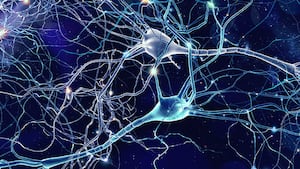Vampires might be on to something when it comes to feasting on blood to stay youthful and immortal—or at least that's the case with mice.
An international team of researchers found that cerebrospinal fluid taken from young mice rejuvenates memory in older mice, according to a new study published Wednesday in the journal Nature. This clear fluid, which surrounds and bathes the brain and spinal cord, is rich with proteins that activate oligodendrocytes, a group of cells that help speed up message delivery within the brain’s vast network of neurons.
“Obviously, we’re not going to be harvesting cerebrospinal fluid and injecting it into people,” Dwight Bergles, a neuroscientist at Johns Hopkins University who was not involved in the study, told The Daily Beast. “But if we could identify which components in there were able to have the largest influence on aging, disease progression, and, in this case, the generation of new oligodendrocytes, then we could think about providing and developing new drugs that stimulate those pathways.”
For over a century, there have been theories that this special sauce wanes with age, and contributes to diminished brain activity and memory. To date, studies have shown that when older mice are transfused with blood or hooked up to the circulatory system of their younger, more vigorous counterparts, it was as if the clock turned back: They gained stronger muscles, faster brains, and more efficient organs.
But even then, studying the full effects and potential benefits of younger blood on the brain has been challenging, Tal Iram, a post-doctoral fellow at Stanford University and the study’s first author, told The Daily Beast. The brain isn’t like the rest of the organs in the body. It’s surrounded by a protective layer called the blood-brain barrier, which limits what can traverse inside and negatively impact our brains like infectious viruses or harmful chemicals.
“Some of the initial motivation for this study was to take a step across those barriers and perform transfers of cerebrospinal fluid, which has a very different protein composition to blood and more unique to the needs of the brain,” said Iram. “We thought that cerebrospinal fluid holds the potential to rejuvenate the brains.”
Iram and her team took cerebrospinal fluid from young adult mice about 10 weeks old. Over the course of a week, the researchers injected the fluid into the brains of 18-month-old mice—which is roughly equivalent to being more than 50 years old in human years. They discovered the infusion improved the older mice’s memory recall in a fear-conditioning task where the animals learn to associate an electric shock with a tone and flashing light.
Interestingly, the region in the mouse brain that seemed to soak in the treatment more than any other was the hippocampus, which is involved in emotions, learning, and memory function. Further, the cells that appeared to benefit the most were oligodendrocytes. It turns out that cerebrospinal fluid contains a growth factor called Fgf17 that the researchers believe helps encourage brain cells to flourish. What appears to be happening, Iram said, is that Fgf17 might be encouraging the growth of new oligodendrocytes—an ability that older brains lose with age.
That oligodendrocyte replenishment bolsters the speed at which electrical signals in the brain are sent. Think of it like repairing a pothole-riddled road that’s preventing cars from driving smoothly.
Bergles, whose own lab at Johns Hopkins studies oligodendrocytes, said these findings echo what scientists have observed when the activity of these cells is impaired.
“There are correlations showing that if you block the production of new oligodendrocytes while you’re training animals in a new motor task, you can actually reduce the ability of those animals from learning the task or reduce an animal’s ability to perform well on memory tasks,” he said.
While the results are promising and could lend insight into how the brain changes with aging and nervous system diseases like multiple sclerosis, Bergles recommends caution before propping up Fgf17 as an anti-aging panacea. If it is as marvelous as the science seems to suggest, we need further experiments that remove the protein from young cerebrospinal fluid to see whether or not that halts oligodendrocytes from maturing.
“Yes, there is sort of a correlation here,” said Bergles. “But the degree to which those things relate to one another is still a bit uncertain, but it’s still certainly provocative.”
“This is the very early stages of basic research that needs to be done to understand the fundamentals of brain aging,” said Iram. “I truly believe these cells could be directly targeted in the future to restore memory function and brain health in general. But we still need to understand these basic mechanisms to design the best therapeutics, and we’re not there yet.”







